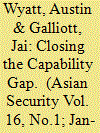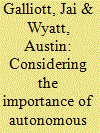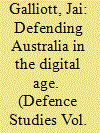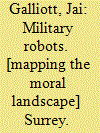|
|
|
Sort Order |
|
|
|
Items / Page
|
|
|
|
|
|
|
| Srl | Item |
| 1 |
ID:
170974


|
|
|
|
|
| Summary/Abstract |
The procurement of autonomous weapon systems is on the rise in Southeast Asia, where, as in other parts of the world, interest in the military applications of unmanned systems is outpacing fractured international regulation efforts. This article analyzes the diffusion of drone technology in Southeast Asia and argues that we are at an inflection point, representing an opportunity for The Association of Southeast Asian Nations (ASEAN) to control the diffusion of unmanned platforms and take a leadership role in developing a regionally appropriate framework for their development. Moreover, it contends that with a regional framework in place to reduce tensions/misadventure, unmanned aerial and maritime vehicles (UAVs & UMVs) could improve ASEAN’s ability to respond to traditional and non-traditional security threats, and thus increase regional security.
|
|
|
|
|
|
|
|
|
|
|
|
|
|
|
|
| 2 |
ID:
185349


|
|
|
|
|
| Summary/Abstract |
The rapidly emerging scholarly literature responding to autonomous weapon systems has come to dominate our perceptions of future warfare. Scientists, governments, militaries, and civil society organisations continue to debate how to respond to their development. This paper draws on empirical data to consider how emerging defence leaders in the Australian Defence Force perceive major elements and questions within the autonomous weapon system literature. In doing so, this paper offers a data-driven end-user interpretation of the potential interactions between military officers and the autonomous weapon systems they may be asked to oversee. In the absence of a pre-emptive ban under international law, this paper presents a call for greater engagement with junior military leadership as a tool for analysing the assumptions made by policy makers and politicians on this issue.
|
|
|
|
|
|
|
|
|
|
|
|
|
|
|
|
| 3 |
ID:
185171


|
|
|
|
|
| Summary/Abstract |
Despite the growing breadth of research related to the perceived risks and benefits of Autonomous Weapon Systems (AWS), there remains a dearth of research into understanding how perceptions of AWS among military officers are affected by design factors. This paper demonstrates that ease of use, and user perception of the concept of using an autonomous weapon system, would be less of a barrier to trusted deployment by this emerging generation of military leaders than ensuring that autonomous systems have robust, transparent and reliable decision-making processes and that operators or supervisors are able to meaningfully monitor the systems nominally under their command. The core contribution of this paper addresses the question of how deliberate design choices could improve or diminish the capacity of junior officers to exercise meaningful human control over autonomous systems.
|
|
|
|
|
|
|
|
|
|
|
|
|
|
|
|
| 4 |
ID:
144729


|
|
|
|
|
| Summary/Abstract |
Australian defence strategy is disjointed and incomplete. Some would say that it is non-existent. Either way, this paper argues that Australia’s underwhelming approach to defence is the product of a crippling geographically focused strategic dichotomy, with the armed forces historically having been structured to venture afar as a small part of a large coalition force or, alternatively, to combat small regional threats across land, sea, and air. However, it is argued that Australia can no longer afford to drift between these two settings and must take measures to define a holistic “full spectrum defence” strategy and develop capability to fight effectively and independently across all domains of the twenty-first century-battlespace: land, sea, air, space, and the cyber realm.
|
|
|
|
|
|
|
|
|
|
|
|
|
|
|
|
| 5 |
ID:
155765


|
|
|
|
|
| Summary/Abstract |
In the face of rapid technological change and the creation of ambitious military modernisation programmes, this paper argues that land forces, in managing the relationship between force levels and the adoption of military robotics, must recognise that there are inherent limits to techno-centric force reduction efforts and realise the inefficacy of substituting skilled soldiers with robots. It begins with an overview of how the proper integration of robotics into a military’s force structure can improve capability, save lives and potentially reduce costs, but suggests that common accounts of robot utility are exaggerated and endanger the risk assessment processes governing the adoption of said technologies and relevant personnel settings. The paper explores the limits of robotic solutions to military problems, discussing their technical limitations, redundancy and related issues that, when combined with a technico-moral skills degradation problem also detailed within, point to the need to reshape force structures to suit the adoption of robotics while preserving existing levels of human staffing.
|
|
|
|
|
|
|
|
|
|
|
|
|
|
|
|
| 6 |
ID:
167698


|
|
|
|
|
| Publication |
Surrey, Ashgate Publishing Limited, 2015.
|
| Description |
ix, 266p.hbk
|
| Series |
Military and Defence Ethics
|
| Standard Number |
9781472426628
|
|
|
|
|
|
|
|
|
|
|
|
Copies: C:1/I:0,R:0,Q:0
Circulation
| Accession# | Call# | Current Location | Status | Policy | Location |
| 059705 | 172.42/GAL 059705 | Main | On Shelf | General | |
|
|
|
|
| 7 |
ID:
176613


|
|
|
|
|
| Summary/Abstract |
The prospect of increasingly autonomous systems has seized the military imagination and rapidly generated an international debate surrounding the merits of a
potential preemptive ban under international law. What has been missing to this
point has been an in-depth consideration of how artificial intelligence, autonomous systems, and unmanned platforms would be perceived by the junior officers
who will play a core role in their integration into future militaries. Drawing on a
broad survey of officer cadets and midshipmen at the Australian Defence Force
Academy conducted in 2019, this article provides an analysis of how perceived
risks and benefits of autonomous weapon systems are influencing the willingness
of these future defense leaders to deploy alongside them.
|
|
|
|
|
|
|
|
|
|
|
|
|
|
|
|
|
|
|
|
|